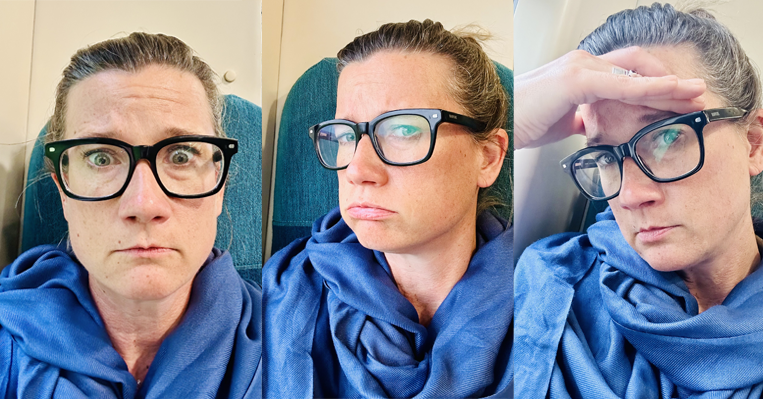
When I feel stressed or overwhelmed, it’s helpful to understand what Driver Behaviours I tend to engage in. Clinical psychologist Taibi Kahler defines Drivers as learnt ways of being and doing to feel in control/ avoid discomfort. These are:
- Be Perfect
- Try Hard
- Please
- Be Strong
- Hurry Up
- Take it/grab it
My top three Drivers are ‘be Perfect’, ‘Try Hard’ and ‘Be Strong’. Qualities which are strengths when I am feeling grounded, but which become unhelpful knee-jerk reactions when I am not. This has an impact on my own health and well-being and that of others in my workspace.
 Driver behaviours can be a warning sign that I am no longer in my ‘Window of Tolerance’ (the space in which I am open, curious, and able to be present with myself and others)[1]. Instead, I feel the signs of becoming dysregulated: an increased heart rate, sweating, change in body temperature, and nausea. Feelings of anxiety, panic, shame and numbness arise – I am tipping into a ‘fight, flight, freeze or flop’ response.
Driver behaviours can be a warning sign that I am no longer in my ‘Window of Tolerance’ (the space in which I am open, curious, and able to be present with myself and others)[1]. Instead, I feel the signs of becoming dysregulated: an increased heart rate, sweating, change in body temperature, and nausea. Feelings of anxiety, panic, shame and numbness arise – I am tipping into a ‘fight, flight, freeze or flop’ response.
If left unchecked, the effects of dysregulation can be harmful for individuals and for organisations: anxiety levels become high and trust low, generating workplace environments which feel wobbly and ‘unsafe’.
This impacts people differently according to their lived experiences of misogyny, racism, homophobia transphobia, ableism, classism, faith based and other forms of discrimination – and positions of power and privilege within and beyond the workplace.
As a conscious leader who is serious about co-creating workplace cultures of genuine welcome, it’s my job to know my patterns intimately, recognise where & how they play out and take action to disrupt them.
Sometimes, however, the trigger takes me by surprise – I can still feel the echo of an adrenaline surge as I recall such a situation…
I was chairing a workshop on developing a new service for LGBTQ+ people impacted by domestic violence. It was all going smoothly until I suggested we carry out a strengths, weaknesses, opportunities and threats (SWOT) analysis to try and ensure this was a service that would be inclusive for LGBTQ+ people across a range of a lived experiences. [shorter sentences, fewer complex words]
I drew this diagram:

As I turned back to the group, I noticed people looking at each other. Someone cleared their throat and said ‘What does the ‘A’ stand for? I think you mean ‘O’! And you’ve got a few words the wrong way round there too’! A few others laughed. I had an instant visceral reaction: my face flushed hot, and my heart began to race; my voice literally caught in my throat.
I felt flooded with shame and flung completely outside my Window of Tolerance. For a moment I froze, overwhelmed with panic… then my ‘Be Strong’ Driver took over: I pasted a smile on my face, made a self-deprecating joke and moved us on to the task at hand. Feelings of shame and being ‘not good enough’ continued to loom large through the workshop and long after the meeting finished. I was certain my credibility as a consultant was in pieces, and so was I – although I hid it well.
Although painful, this was an ‘aha’ moment for me: as a neurodivergent person with dyslexia, dyspraxia and dyscalculia, mis-spelling and -naming words, forgetting words, names, directions, instructions, and struggling to process information are day-to-day realities – alongside the gifts brings. I am learning how to stay connected with myself, and others, in these moments, to challenge stereotypes and bias where they arise – in myself and others – and to practise acceptance. This is a lifelong practice and one I am whole heartedly committed to.
Connecting with physical sensations in my body helps me return to my Window of Tolerance when my Drivers have taken over. It doesn’t always feel possible or safe to do this. But when I can, it brings me back to the here and now, and I find my body gradually starts to relax. This is what is sometimes called ‘rest and digest’ and helps me:
- get to know myself and my Drivers better and recognise more clearly and quickly when I am working at the edge of my Window of Tolerance
- re-connect with my ‘here and now’ experience and act from there, rather than from my place of triggered fear, annoyance or hurt
- maintain a healthier connection with others who are present
- over time expand my Window of Tolerance.
Noticing what is allows me to interrupt habits, such as rushing from one task to the next, or avoiding certain people or situations. I am more ready to move toward that uncomfortable conversation which is long overdue!
I am less prone to shame and self-punishment – both of which I recognise as young feelings associated, in part, with my lived experience as a disabled person. I am more effective in challenging others – like the participants in that workshop – when they engage in unmindful micro-aggressions. Noticing what is provides me with the sensory information I need to nourish myself and others, and shape my choices, intentions and actions as an embodied, imperfect, courageous conscious leader.
How does this chime with you? Can you tune into…
- When you start to feel overwhelmed?
- What is going on in your body when this happens?
- Can you stay present with your raw experience, even for a moment or two?
- If so, what do you learn about your Drivers?
- What helps you to stay regulated, feel more grounded and support yourself and others as a Conscious Leader?
Dan Siegal (executive director of the Mindsight Institute)





